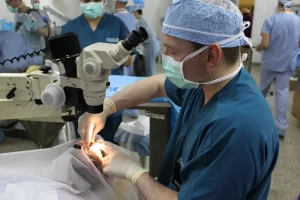
Cataract surgery devices are medical devices used in the surgical removal of cataracts, which are clouding of the eye’s natural lens. Cataracts are a common condition, especially in older adults, and they can cause blurred vision, sensitivity to light, and other visual impairments. During cataract surgery, the clouded lens is removed and replaced with an artificial intraocular lens (IOL). Cataract surgery devices are used to perform various steps of the surgical procedure, including making incisions, removing the lens, and inserting the IOL. The global Cataract Surgery Devices Market size was valued at $8.3 billion in 2020 and is projected to reach $12.2 billion by 2030, growing at a CAGR of 3.9% from 2021 to 2030.
Cataract surgery devices are subject to regulatory approval and are designed to be safe and effective for use in a surgical setting. The choice of specific devices used in cataract surgery may vary depending on the surgeon’s training and preferences, as well as the specific characteristics of the patient’s eye.
Cataract surgery is typically performed using specialized equipment that is specifically designed for the procedure. Some common machines and devices used in cataract surgery include:
- Phacoemulsification machine: This machine uses ultrasonic energy to break up the cataract into tiny fragments, which are then suctioned out of the eye. The phacoemulsification machine typically consists of a handpiece with an ultrasonic probe, an irrigation/aspiration system to remove the fragmented lens material, and a control console.
- Femtosecond laser: This laser can be used to create precise incisions in the cornea and lens capsule, soften the lens for easier removal, and even divide the lens into sections for easier removal. The femtosecond laser is typically computer-controlled and uses rapid pulses of laser light to perform the surgical tasks.
- Operating microscope: An operating microscope is used to provide a magnified view of the eye during the surgical procedure. This allows the surgeon to see the various structures of the eye in greater detail and perform the delicate maneuvers required during cataract surgery.
- IOL injector: An IOL injector is a device that is used to insert the artificial lens into the eye through a small incision. The injector helps to position the lens correctly in the eye and ensures that it unfolds properly once it is inserted.
- Ophthalmic viscosurgical device (OVD): An OVD is a gel-like substance that is used to protect the cornea and other structures of the eye during cataract surgery. The OVD helps to maintain the shape of the eye and provides a clear view for the surgeon.
Cataract surgery machines and devices are subject to regulatory approval and are designed to be safe and effective for use in a surgical setting. The specific equipment used during cataract surgery may vary depending on the surgeon’s training and preferences, as well as the specific characteristics of the patient’s eye.
Download Free Sample PDF:
https://www.alliedmarketresearch.com/request-sample/2609
Phacoemulsification, also known as “phaco,” is the most popular technique for cataract surgery. It is a modern, minimally invasive surgical technique that uses ultrasound energy to break up the cataract into tiny pieces, which are then suctioned out of the eye. Phacoemulsification typically involves a small incision of 2.2-2.8 mm and is performed using local anesthesia with or without sedation. The procedure usually takes around 10-15 minutes to complete and can be performed on an outpatient basis.
Phacoemulsification has several advantages over older cataract surgery techniques, such as extracapsular cataract extraction (ECCE) and intracapsular cataract extraction (ICCE). These advantages include faster recovery time, fewer complications, and improved visual outcomes. In addition, phacoemulsification can be combined with other advanced techniques, such as femtosecond laser-assisted cataract surgery (FLACS), to further improve surgical outcomes and reduce the risk of complications.
Phacoemulsification has become the standard of care for cataract surgery in many countries and is widely considered to be a safe, effective, and minimally invasive surgical technique for the treatment of cataracts.
Femtosecond laser-assisted cataract surgery (FLACS) is one of the latest and most advanced technologies used in cataract surgery. This technique uses a high-precision femtosecond laser to perform some of the key steps of cataract surgery, such as creating incisions in the cornea and lens capsule, and softening the lens for easier removal.
FLACS is a computer-controlled technique that is more precise and reproducible than traditional manual techniques. This technology has several potential benefits for cataract surgery, including:
- Improved accuracy and precision: The femtosecond laser allows for more precise and predictable incisions and lens fragmentation, leading to better surgical outcomes.
- Reduced risks of complications: FLACS can reduce the risk of some complications associated with traditional cataract surgery, such as capsule tears and corneal damage.
- Customization: The femtosecond laser can be programmed to create incisions and lens fragmentation patterns that are customized to the individual patient’s eye, improving surgical outcomes.
Other advanced technologies used in cataract surgery include the use of advanced intraocular lenses (IOLs) that can correct for astigmatism or provide multifocal vision, improving visual outcomes after surgery. Additionally, improved surgical techniques and instrumentation, including better phacoemulsification machines and microsurgical instruments, can also improve surgical outcomes and patient satisfaction.
It’s worth noting that while FLACS and other advanced technologies can improve surgical outcomes, they may also increase the cost of cataract surgery. The decision to use advanced technologies in cataract surgery should be made on a case-by-case basis, taking into account the patient’s individual needs and preferences.
Contact:
David Correa
USA/Canada (Toll Free): +1-800-792-5285, +1-503-894-6022

